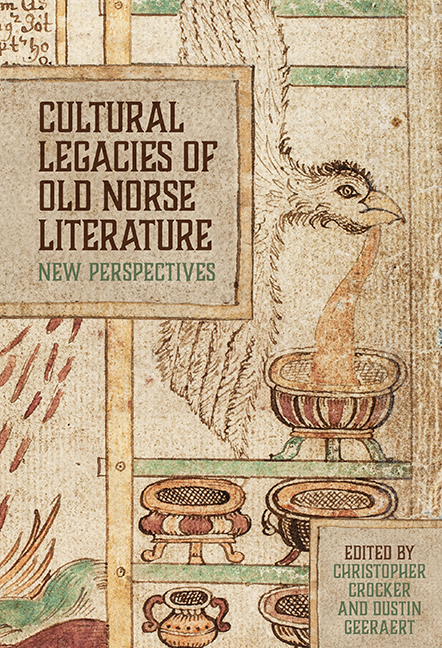Book contents
- Frontmatter
- Contents
- List of Illustrations
- List of Contributors
- Foreword: Old Norse and the Porous Boundaries of Medievalism
- Acknowledgements
- Note on the Text
- Introduction
- 1 Dr Jekyll and Mr Hyde in Medieval Iceland: Saga Realism and the Sworn Brothers
- 2 The Malleability of the Past: Íslendingabók as Narrative History
- 3 Women’s Work and Material Culture in Medieval Iceland: Gender, Narrative, and Cloth Production
- 4 Vafþrúðnismál, from Parchment to Print: Stability and Change in the Transmission of Eddic Poetry
- 5 The Odinic Motif: The Wanderer in the Mist
- 6 What has Darwin to do with Óðinn? Shapeshifting, God, and Nature in the ‘Great Story of the North’
- 7 Madness, Mythology, and Mitteleuropa: Günter Grass’s Transformation of Old Norse Myth in The Tin Drum
- 8 Once More, with Fiction: Transforming Myth in Gerður Kristný’s Blóðhófnir and the Eddic Poem Skírnismál
- Afterword: Ethnographic Medievalisms
- Bibliography
- Index
5 - The Odinic Motif: The Wanderer in the Mist
Published online by Cambridge University Press: 08 October 2022
- Frontmatter
- Contents
- List of Illustrations
- List of Contributors
- Foreword: Old Norse and the Porous Boundaries of Medievalism
- Acknowledgements
- Note on the Text
- Introduction
- 1 Dr Jekyll and Mr Hyde in Medieval Iceland: Saga Realism and the Sworn Brothers
- 2 The Malleability of the Past: Íslendingabók as Narrative History
- 3 Women’s Work and Material Culture in Medieval Iceland: Gender, Narrative, and Cloth Production
- 4 Vafþrúðnismál, from Parchment to Print: Stability and Change in the Transmission of Eddic Poetry
- 5 The Odinic Motif: The Wanderer in the Mist
- 6 What has Darwin to do with Óðinn? Shapeshifting, God, and Nature in the ‘Great Story of the North’
- 7 Madness, Mythology, and Mitteleuropa: Günter Grass’s Transformation of Old Norse Myth in The Tin Drum
- 8 Once More, with Fiction: Transforming Myth in Gerður Kristný’s Blóðhófnir and the Eddic Poem Skírnismál
- Afterword: Ethnographic Medievalisms
- Bibliography
- Index
Summary
A craggy, square face with pale gray eyes. The suit looked expensive, and was the color of melted vanilla ice cream. His tie was dark gray silk, and the tiepin was a tree, worked in silver: trunk, branches, and deep roots.
Neil GaimanIn creating the alluring Mr Wednesday, as described above, Neil Gaiman drew inspiration from a mysterious figure that has appeared in Icelandic literature over many centuries. He is a wanderer, a counsellor, a shapeshifter, a magician, and a master of the outcome of battle. He is often mysteriously veiled in shadow, at times being revealed as the Norse god Óðinn. This paper aims to establish how characteristics of this god have been utilised to illuminate other characters with the same brilliance, and in what ways the divine and wise All-father brings his audience to childlike wonder. The present discussion assesses and contrasts the literary and folkloristic associations with the recurrent Odinic character in a broad range of works. For example, the same wanderer motif that is used when introducing the god Óðinn in the work of the Danish historiographer, Saxo Grammaticus, is used to represent old wanderers that are instead associated with long past kings. These kings appear in the kings’ sagas, a type of medieval historiographical work created in Iceland where this motif makes several appearances. It is not always the god himself that has become important for the audience, but rather it is the motif that was created from him to strike awe in the receiver, whether they be a reader, listener, or viewer. We are witness to a myriad of medieval, modern, and contemporary Odinic narratives through a particular set of lenses we might more naturally refer to as genres. This motif forms a kaleidoscope pattern under a set of Odinic lenses as we look through a history of works spanning more than a thousand years.
In Gunnar Gunnarsson's modern novel, Guest the One-Eyed (1913), orig-inally published in Danish as a volume of the Borgslægtens historie series (The History of the Family at Borg), a wonderful description of the Guest character utilizes not only one of Óðinn's names but also the one eye and other characteristics of the Odinic motif:
His heavy coat dragged like the wings of a wounded bird. It was a picture well in keeping with the landscape, the man with his long white beard, the tangled grey hair showing below a big soft hat of the indeterminate colour of age.
- Type
- Chapter
- Information
- Cultural Legacies of Old Norse LiteratureNew Perspectives, pp. 88 - 112Publisher: Boydell & BrewerPrint publication year: 2022



